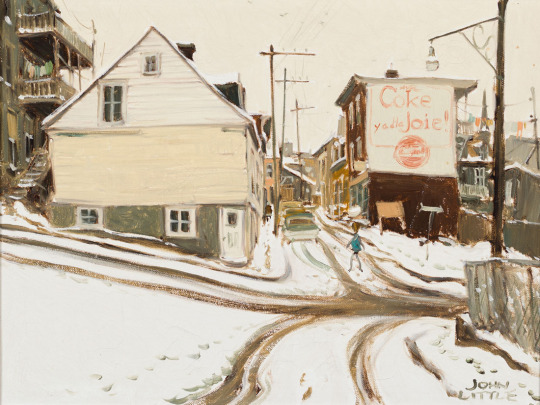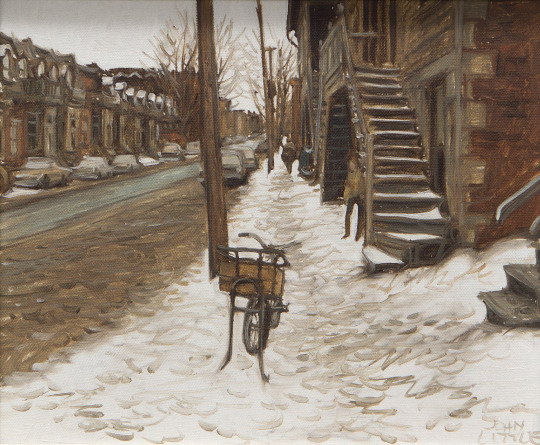#john geoffrey caruthers little
Explore tagged Tumblr posts
Text

John Little (Canadian, 1928-2024), Rue O'Connell Angle St-Simon, in Disappearing Quebec, 1968. Oil on canvas, 12 x 16 in.
#john little#canadian art#snow#street scene#rue o'connell#quebec#québec#john geoffrey caruthers little
5K notes
·
View notes
Note
Hi there! Hope your day is going well! You've mentioned before you were using trauma theory in your work, would you have any recommended reading about this that you found helpful or useful? Thanks : )
Hi!! I've started off well and I hope your day goes well too!
Oh boy do I. Let me go pull up my Qual list.
If you only read one article, it should be Radstone's that I'll cite below. She explains the origins, the intentions, and the ethical questions of the field in an extremely comprehensive and comprehensible way. Obviously, it's a little dated and thus can't take into account different moves made more recently, but she pulls up issues that recent work ends up addressing.
Radstone, Susannah. “Trauma theory: Contexts, Politics, Ethics”. Paragraph 30 no 1 (2007): 9–29.
Below the cut are several more recommendations. I've commented on the ones for which I have something useful to say.
Traditional/Foundational texts
Freud, Sigmund. Beyond the Pleasure Principle. New York: Liveright, 1961.
Freud, Sigmund. “Screen Memories”. 1899.
Freud, Sigmund. “Mourning and Melancholia” in The Freud Reader. ed. Peter Gay. New York: W.W. Norton and Co., 1989.
With my deepest apologies, I do have to acknowledge that trauma theory is psychoanalytic and particularly Freudian in origin. You do not need to read these, but having at least skimmed them will help you understand what people are referring to in later works. Pleasure Principle is the big one - and is pretty short. There are also some cases from On the Interpretation of Dreams that come up (the burning child, a rat one), but usually those are explained in-text anyway.
Caruth, Cathy, ed. Trauma: Explorations in memory. Baltimore: Johns Hopkins University Press, 1995.
Caruth, Cathy. Unclaimed Experience: Trauma, Narrative and History. Baltimore: Johns Hopkins University Press, 1996.
Caruth is one of the Big Names in original trauma theory - I believe she's currently at Cornell. These texts are what everyone refers to, whether they agree with her or not. I'd definitely give them a look over.
Leys, Ruth. Trauma: A genealogy. Chicago: University of Chicago Press, 2000.
Leys approaches trauma theory from a more practical (as in how we practice, medically) angle especially in the start of the book, but she is extremely thorough in discussing the origins of trauma theory - and makes some important/interesting criticisms of Caruth's work.
Laub, Dori; Felman, Shoshana. Testimony: Crises of Witnessing in Literature, Psychoanalysis and History. New York: Routledge, 1991.
Felman and Laub have different academic backgrounds and focuses, which means that this book provides several different approaches and interpretative angles, using trauma theory approaches. I particularly like Laub's concept of the "listener" in the recitation of trauma. (It's worth noting that Laub himself is a survivor of the Shoah, which he discusses in terms of his multiple witness positions in a chapter).
Hartman, Geoffrey. “On Traumatic Knowledge and Literary Study.” New Literary History 26, no 3 (1995): 537–63.
Felman, Shoshana. The Juridical Unconscious: Trials and Traumas in the Twentieth Century. Cambridge: Harvard University Press, 2002.
Newer horizons
Luckhurst, Roger. The Trauma Question. 2008.
Talks about trauma theory approaches particularly in regards to artistic production (film, painting, writing).
Buelens, Gert; Durrant, Samuel; Eaglestone, Robert eds. The Future of Trauma Theory: Contemporary Literary and Cultural Criticism. London: Taylor and Francis, 2013.
An edited volume with chapters that address many of the criticisms of original trauma theory! (eurocentrism, logocentrism, for example)
Sanyal, Debarati. Memory and Complicity: Migrations of Holocaust Remembrance. New York: Fordham University Press, 2015.
Rothberg, Michael. The Implicated Subject: Beyond Victims and Perpetrators. Stanford: Stanford University Press, 2019.
A lot of trauma theory has a sort of binary victim/perpetrator dichotomy, but Rothberg looks at the 'implicated subject', someone connected but not always a direct participant in traumatic events, which I find very helpful.
Not quite trauma theory but potentially helpful
Benjamin, Walter. “The Storyteller” in The Storyteller Essays. New York: New York Review Books, 2019.
Rothberg, Michael. Multidirectional memory. Stanford: Stanford University Press, 2009.
Sontag, Susan. Regarding the Pain of Others. New York: Picador, 2003.
#my answers#lit theory#some of the particular editions ive cited are simply bc those are the ones i used#im extremely biased bc radstone was the first trauma theory text i read#but i do think she's very helpful
7 notes
·
View notes
Photo
John Little (Canadian, 1928-2024), Rue de Bullion, Montréal, 1979. Oil on canvas, 25.4 x 30.5 cm.

Rue de Bullion, Montréal - John’ Geoffrey Caruthers Little , 1979.
Canadian, b. 1928 -
Oil on canvas , 25.4 x 30.5 cm.
1K notes
·
View notes
Photo

Hiver – Rue Henri Julien, Montréal (1977) by John Geoffrey Caruthers Little
1 note
·
View note
Photo

John Geoffrey Caruthers Little (b. 1928), Sunday Morning - Evan's Place (Between St. Urbain And Clarke), Overnight Snowfall, Montreal, 1968. oil on canvas, 61.5 x 77 cm
#john geoffrey caruthers little#canadian art#winter light#sunday morning#montreal#realism#urban landscape#under the snow#'60s
304 notes
·
View notes
Photo

John Geoffrey Caruthers Little (1928-) Une Journee Estival, Avenue Coloniale, Mtl 1981 (61 by 76 cm)
4 notes
·
View notes
Text

John Geoffrey Caruthers Little - Rue Plessis Vers Lafontaine, Montreal (1978)
122 notes
·
View notes
Photo

John Geoffrey Caruthers Little (Canadian, b.1928) Un Magasin Du Coin Pointe St. Charles "Avec Coke Y'a D'la Joie"
Dimensions: 10 X 12 in (25.4 X 30.48 cm) Medium: oil on canvasboard Creation Date: 1976
332 notes
·
View notes
Photo

John Little (Canadian, 1928-2024), Sherbrooke at Peel, 1956. Oil and graphite on board, 24 x 30 in.
744 notes
·
View notes
Photo

September Evening, Rue Marie-Anne, Montréal by John Geoffrey Caruthers Little
2K notes
·
View notes
Photo

Rooftops - John’ Geoffrey Caruthers Little , 1954.
Canadian, b. 1928 -
Oil on canvas , 25.4 x 30.5 cm.
1K notes
·
View notes
Photo

John Geoffrey Caruthers Little (b. 1928), R.C.A.Motor Vessel, “Fort Lévis”, At Ste. Laurent, Île D'Orléans, P.Q., 1998. oil on canvas, 25.5 x 38 cm
42 notes
·
View notes
Photo

John Geoffrey Caruthers Little (1928-) September Evening, Rue Marie-Anne, Montreal 1964 (23 by 30,5 cm)
73 notes
·
View notes


